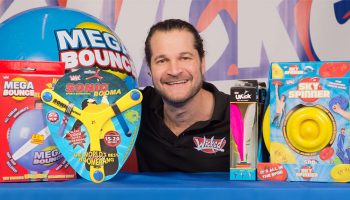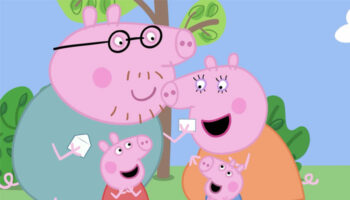Prolific inventor Brad Ross on the key to successful creative collaborations

Brad, thanks for making time. To kick things off, how did you come to be inventing in the toy and game space?
I was, and still am, involved in making music as a composer, songwriter, and pianist. I come from a musical family. I love writing songs and shows for kids. A while back, I’d written a song called ‘Little By Little’. It’s an adorable song about growing up. Someone heard it and introduced me to Maureen and Laurie Trotto. I developed a relationship with them and that’s how I got started inventing toys and games.
Was it a straightforward leap or a steep learning curve?
My outlook is that there’s always something to learn. It was true when I started out and it’s true now. I’m constantly trying to figure out how to create to the best of my ability. That said, we got lucky very quickly with an option from Hasbro, so that was nice! From then on, I just grew to love the toy and game industry and soaked up as much as I could.
What was one of the first concepts you licensed?
One of my early games – and one of my favourites – was Toot and Otto which came out from ThinkFun. I showed the prototype at New York Toy Fair and licensed it shortly thereafter.

The games sees players having to spell ‘Toot’ or ‘Otto’ on the grid pictured above… Is it still with ThinkFun?
No but I’m hopeful that a different company will be giving it a fresh start in ‘23.
We’ll see. Fingers crossed!
Great! We’ll keep our eyes peeled. Let’s discuss how you design… Do you work alone? With partners?
I’ve done a good bit of inventing on my own, but I also like to partner with people. I find that the dialogue between two – or even three – creative minds sometimes brings unexpectedly wonderful results.
What’s the key to making those kinds of inventor partnerships work?
I like to work with people who are smarter or more creative than me – which many people are! The key to making a partnership work is respecting the people you’re working with and knowing that they might think of something that I didn’t. At the end of the day, I just enjoy tossing ideas around with smart talented people. Often times, I try to find partners who have an area of expertise that I’m lacking… For example, industrial designers, model makers, and electronics specialists.
In terms of partners, I’m grateful to have worked with people like Mike Hirtle, Bob Jeffway, and Don Ullman, three amazing guys. There are also some industrial designers I adore like Barry Morgan and Ivy and Gary Strauss. They’re wonderful. I’m partnered on a game now with Richard Levy; he’s a living legend! I’ve also done stuff with Matt Andersen, Ed Gartin, Dan Klitsner, and Ross Magers who are all absolutely fantastic. And I have to mention Michael Kohner who is always generous with his time and vast expertise. Recently, I’ve created a couple of great toy concepts with a fabulous illustrator, Jessica Knapp.
I’m grateful for all my partnerships, and as a quick aside, I’m always interested in meeting other talented inventors. Please feel free to get in touch at [email protected].
An incredible list of collaborators there. How does it tend to work? Do you split duties or is it a bit more organic?
I find that a collaboration has to begin with one person – usually me – proposing an idea, or a mechanism, or a sketch, or pulling something out of the trunk. You can’t come in empty handed. You have to put something on the table to get the ball rolling.
My feeling is that, if I come in with 10 ideas, there’s a better chance something will ignite than if I just bring one idea to the table. Once we have an idea that excites both of us, we figure out next steps in terms of tasks.
You’ve licensed lots of things to different companies. So on the flip-side, what do you think is the key to a successful company/inventor relationship?
The one thing I tell myself is that I want all my relationships to be long-term. I feel it’s important to keep all your relationships positive so that you can knock on that door again in the future.
A smart mantra! You mentioned earlier about bringing lots of ideas to the table, but how do you have ideas, Brad? What inspires you?
I like to have some direction, whether it’s from a company’s wishlist or something that I perceive the market wanting more of. I’m always jotting ideas down in a notebook or recording a quick voice memo on my phone. Starting with a specific focus or direction is key for me.
You’ve been doing this for decades now so I’m curious… What advice would you give to a budding inventor?
Make sure your ideas are well conceived, nicely prototyped, and clearly presented. And it’s essential that the video conveys the concept effectively.
Great advice. Before I let you go, let’s talk about some of your recent and upcoming launches! What should we know about?
My game, BrainBolt, is doing well with Educational Insights. In September, they’re
bringing out BrainBolt Genius, which includes a game of mine. Schmidt Spiele
is introducing Memo Flash – the same game as BrainBolt – to their markets soon.

Elsewhere, Winning Moves came out with Scattergories Stackagories last month and Cheatwell Games did their own version called Top It and showed it at DISTOY. Piatnik recently launched two games: Mimix and Tick Tack Bumm Pocket. And Ravensburger is doing Minion-Alarm.

Spin Master has a game on the market called Quick Pucks and WowWee is doing Hands Full! Mindware published Triumph Of The Temple. GibGab came out with Fat Brain Toys and was nominated for Game of the Year. All of these companies are first rate.

What a list! You also have Tiltago launching soon with Fat Brain Toys, right?
Yes! I love Tiltago! Fat Brain introduced it at ASTRA. You have to tilt the tubes to get the balls in a specific order – it combines fidget, strategy and speed. My partners are Ed Gartin and Matt Andersen. Fat Brain has done a fantastic job on this.
Simple but genius! It looks like the sort of thing you’d pick up and play with, even if you had no idea what it was!
Yes, this is one of those dexterity games where the goal is self-evident. You don’t need rules.

Nice. You also have a few games coming out with John Adams?
Yes, there’s Topple Off! which I did with Bob Jeffway. The original prototype involved balancing something in the palm of your hand. They’ve tweaked it but the skill set still involves balancing. They’ve done a really nice job!
They’re also doing 60 Seconds, a co-invention with Bob Jeffway and Mike Hirtle. Bob built the prototype of the electronic gizmo. Mike and I contributed on the game-play side. John Adams is a wonderful company.

Both look fab. Brad, a huge thanks for taking time out for this! Let’s tie-in again soon.
Thank you, Billy! And as mentioned, I welcome new partnerships. Please reach out at [email protected].
–
To stay in the loop with the latest news, interviews and features from the world of toy and game design, sign up to our weekly newsletter here

























